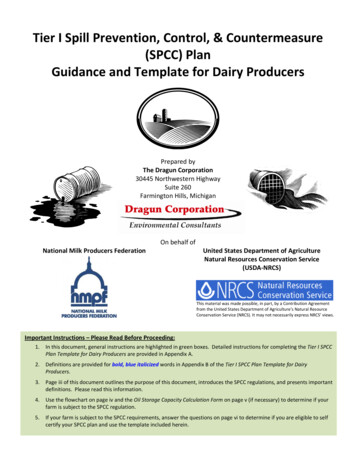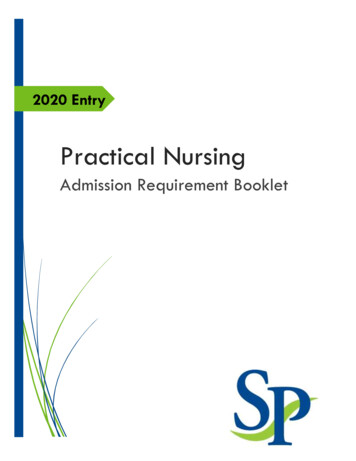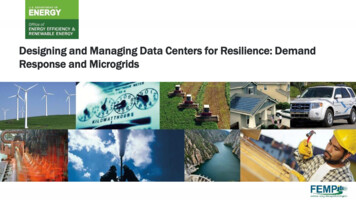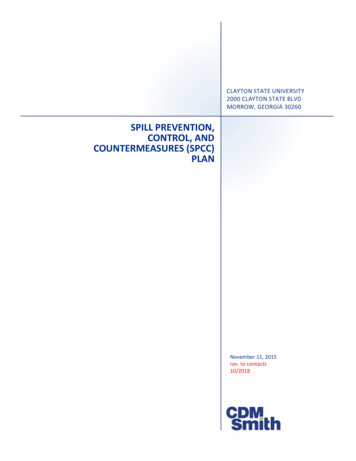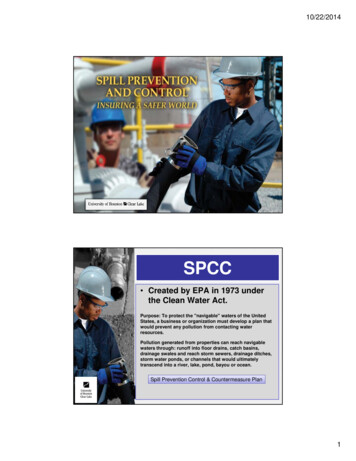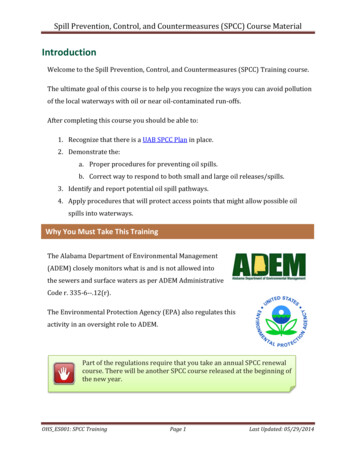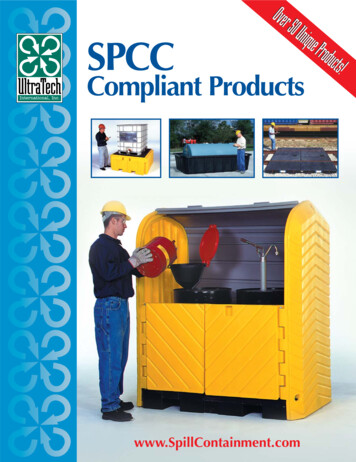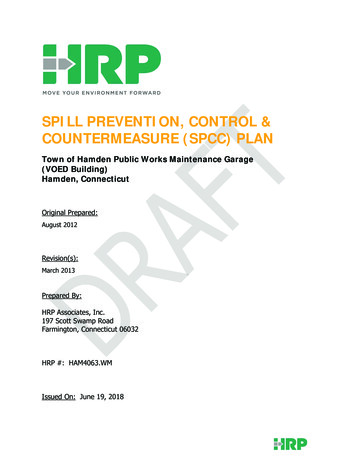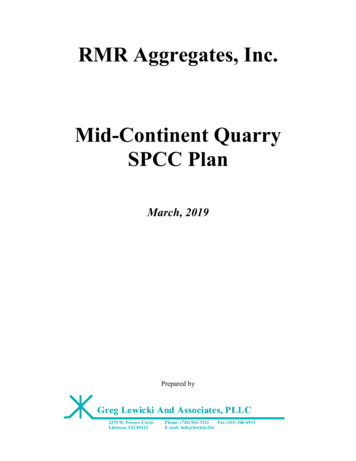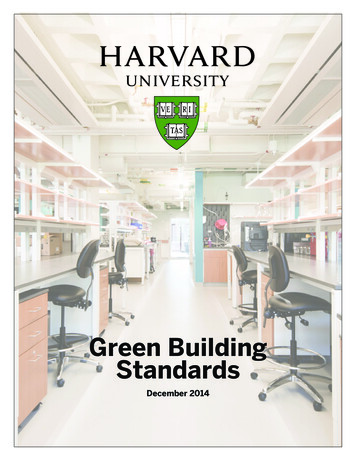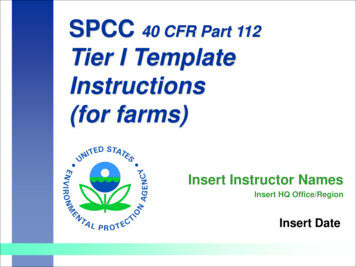
Transcription
SPCC 40 CFR Part 112Tier I TemplateInstructions(for farms)Insert Instructor NamesInsert HQ Office/RegionInsert Date
Today’s AgendaI.II.III.SPCC/Qualified Facility ApplicabilityTier I Qualified Facility SPCC Plan TemplateQuestions and Answers
Part I:SPCC/ QualifiedFacilityApplicability
Is the facility or part of the facility (e.g., complex) considered nontransportation-related?NOYESIs the facility engaged in drilling, producing, gathering, storing,processing, refining, transferring, distributing, using, or consuming oil?NOYESCould the facility reasonably be expected to discharge oil in quantitiesthat may be harmful into navigable waters or adjoining shorelines?NOThe facility isnot subjectto SPCC RuleYESIs the total aggregate capacity ofaboveground storage greater than1,320 U.S. gallons of oil?Is the total aggregate capacity ofcompletely buried storage greater than42,000 U.S. gallons of oil?(Do not include the capacities of:- completely buried tanks and connected(Do not include the capacities of:underground piping, ancillary equipment,- less than 55-gallon containers,and containment systems subject to all of- permanently closed containers,the technical requirements of 40 CFR part- motive power containers,OR 280 or 281,- hot-mix asphalt and hot-mix- nuclear power generation facilityasphalt containers,underground emergency diesel generator- single-family residence heatingtanks deferred under 40 CFR part 280 andoil containers,licensed by and subject to any design and- pesticide application equipmentquality criteria of the Nuclear Regulatoryand related mix containers, orCommission,- containers used exclusively for- permanently closed containers, ortreating wastewater)- containers used exclusively for treatingwastewater)YESThe facility issubject toSPCC RuleNO
Qualified Facility ApplicabilityIf the facility total aboveground oil storage capacity is 10,000 gallons or less And And the facility has Then the facility is a:Within three years prior to theTier I Qualified Facility:Plan certification date, orNo individual abovegroundComplete and self-certifysince becoming subject to the oil containers greater thanPlan template (Appendix G5,000 gallons;SPCC rule if in operation forto 40 CFR part 112) in lieu ofa full PE-certified Plan.less than three years, thefacility has not had: A single discharge of oil tonavigable waters orTier II Qualified Facility:adjoining shorelinesPrepare a self-certified Planexceeding 1,000 gallons,Any individual aboveground in accordance with allorapplicable requirements ofoil container greater than Two discharges of oil to5,000 gallons;§112.7 and subparts B or Cnavigable waters orof the rule, in lieu of a PEadjoining shorelines eachcertified Plan.exceeding 42 gallonswithin any 12-monthperiod.11Notincluding discharges that are the result of natural disasters, acts of war, or terrorism. When determining the applicabilityof this SPCC reporting requirement, the gallon amount(s) specified (either 1,000 or 42) refers to the amount of oil thatactually reaches navigable waters or adjoining shorelines not the total amount of oil spilled. EPA considers the entire volumeof the discharge to be oil for the purposes of these reporting requirements.
Examples of Oil GasolineOff-road and on-road diesel fuelHydraulic oilLubrication oilCrop oilVegetable oils from cropsAdjuvant oilMilk** Milkand Milk product containers are now exempt from the SPCC capacitycalculations and rule requirements
What is a “Reasonable Expectation ofan Oil Discharge”? Initial determination by the owner/operator based ongeographical and location aspects of the farm You may consider proximity to water, land contour,drainage Exclude manmade features, such as secondarycontainment dikes around tanks and impoundments, indetermination Good idea to document determination– Particularly if you conclude you are not subject to the rule– Not a rule requirement See Section 2.4 of SPCC guidance cc/guidance/2Applicability.pdf
Part II:Tier I QualifiedFacility SPCCPlan Template
Doe’s Family Farm(fictional scenario) Doe’s Family Farm is comprised of multiple parcels ofland totaling approximately 2,800 acres on which rice,corn and soybeans are grown on a rotational basis. The farm is adjacent to an unnamed tributary of theWhite River. The main operational area of the farm includes sheds tostore equipment, a tractor repair and maintenance shop,fuel storage and transfer area, silos for storing corn, anda single-family residence.
Doe’s Family Farm Spill History:– The farm had the following discharges in the three yearsprior to the date that Mr. Doe certified his Plan(04/12/2011):– August 12, 2009 - 50 gallons gasoline reached the WhiteRiver;– January 20, 2010 - 100 gallons diesel oil (25 gal. to thetributary to the White River);– September 16, 2010 - 60 gallons diesel oil to secondarycontainment.
Facility Diagram
Does the Doe Family Farm Need anSPCC Plan? Is the facility or part of the facility considered nontransportation related?– Yes, the facility stores, uses, and consumes oil – all nontransportation related activities. Is the facility engaged in drilling, producing, gathering,storing, processing, refining, transferring, distributing,using, or consuming oil?– Yes, the facility stores, uses, and consumes oil. Could the facility reasonably be expected to discharge oilin quantities that may be harmful into navigable watersor adjoining shorelines?– Yes, an oil spill from the facility could reach the tributarythat leads to the White River.
Does the Doe Family Farm Need anSPCC Plan? (cont.) Is the total aggregate capacity of aboveground oilstorage containers greater than 1,320 gallons of oil; or isthe total aggregate capacity of completely buried storagetanks greater than 42,000 gallons of oil?– Yes, the aboveground oil storage capacity is 7,980gallons.CONCLUSION: An oil spill from the Doe Family Farm mayreach a navigable waterway and the aboveground oil storagecapacity is greater than 1,320 gallons. John Doe needs todevelop an SPCC Plan.
Can John Doe Certify the SPCC Planand Complete a Tier I Template? Has the facility had any oil spills that reached navigablewaters in the past three years?– Yes, oil spills from this facility can and did reach navigablewaters. Were any of these oil spills larger than 1,000 gallons?– No. Was oil spilled to navigable waters more than once in a12-month period?– Yes, on August 12, 2009 and again on January 20, 2010.
Can John Doe Certify the SPCC Plan andComplete a Tier I Template? (cont.) Did more than 42 gallons of spill oil reach navigablewaters in both discharges?– No. On January 20, 2010 only 25 gallons reachednavigable waters. Although the farm had two discharges ofoil to navigable waters, there was no single discharge of oilto navigable waters exceeding 1,000 U.S. gallons, nor twodischarges of oil to navigable waters each exceeding 42U.S. gallons within any twelve-month period. Is the aboveground oil storage capacity 10,000 gallonsor less?– Yes, the Doe Family Farm is a qualified facility and JohnDoe can certify the SPCC Plan.
Can John Doe Certify the SPCC Plan andComplete a Tier I Template? (cont.) Are any aboveground oil storage containers at the farmlarger than 5,000 gallons capacity?– No.CONCLUSION: The Doe Family Farm is a Tier I QualifiedFacility and John Doe can complete the SPCC Plan template inAppendix G of the rule (as long as he does not deviate from anyrule requirements).
Cover Page: Instructions Can be completed electronically or handwritten onprinted copy– A hardcopy of the final Plan must be kept at facility Template covers all SPCC requirements for a Tier Iqualified facility Becomes the facility’s SPCC Plan when fully completed A checked box on the template indicates that therequirement has been adequately addressed Not all items/sections of the template are applicable to allfacilities.– Non-applicable items can be identified/checked as “N/A” Some sections require written descriptions and/or listings
Need more information?Each section highlights therule requirements that apply
Example Calculation:Single Vertical Cylindrical TankInside a Rectangular or Square Dike or BermSteps:1. Determine the volume of the secondary containment,VSC2a. Determine the volume of the tank when the tank shellcapacity is unknown, VTank2b. Determine the volume of the tank when shell capacity isknown, VTank3. Determine the percentage of the secondarycontainment volume, VSC to the tank volume, VTank4. Determine whether the secondary containment cancontain the entire tank shell capacity with additionalcapacity to contain rain.
Tank shell capacityIn this example the tank is1,200 gallons, the tankdiameter is 5 ft, and tankheight is 8 ft. Secondary containmentlength, width, and heightSee diagram fordimensions. Rainfall amountRainfall can collect in thesecondary containment;the selected rain event forthe location is 7 inches.
Table G-16 (cont.)
Table G-16 (cont.)
Attachment 4
Part III:Questions andAnswers
For More Information EPA’s SPCC web page- htm EPA’s SPCC for Agriculture web page- http://www.epa.gov/osweroe1/content/spcc/spcc ag.htm EPA Oil Spill and Emergency Management web pages- www.epa.gov/oilspill- www.epa.gov/emergencies HOTLINE: Superfund, TRI, EPCRA, RMP, and OilInformation Center- (800) 424-9346 or (703) 412-9810- TDD (800) 553-7672 or (703) 412-3323- www.epa.gov/superfund/resources/infocenter
Available Tools Available on EPA’s SPCC web page and EPA’s SPCC forAgriculture web page- Tier I Template- Example Tier I SPCC Plan- Secondary Containment Calculation Worksheets andExamples
SPCC Contacts
SPCC Contacts
Questions?
Template covers all SPCC requirements for a Tier I qualified facility Becomes the facility's SPCC Plan when fully completed A checked box on the template indicates that the requirement has been adequately addressed Not all items/sections of the template are applicable to all facilities.
